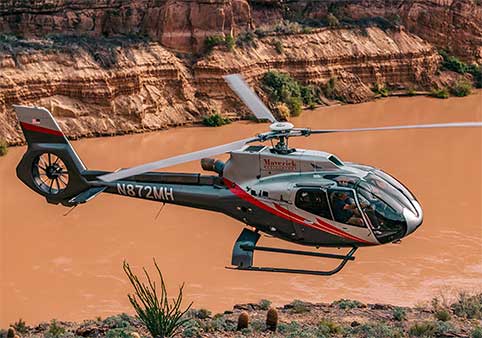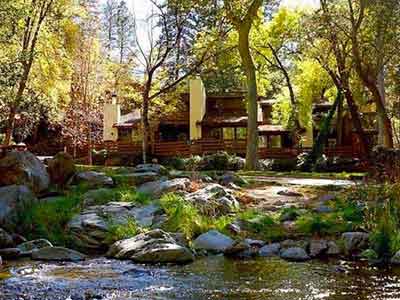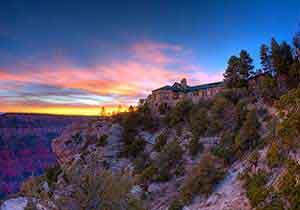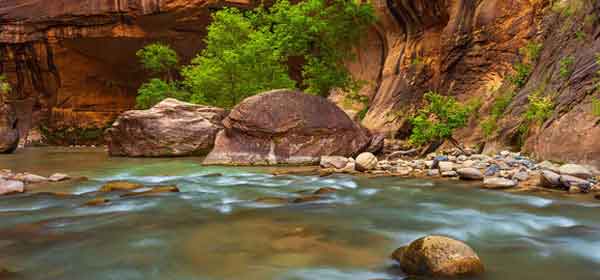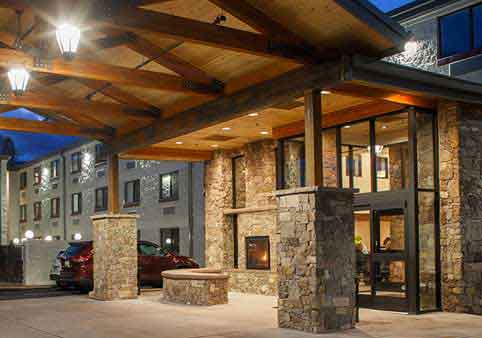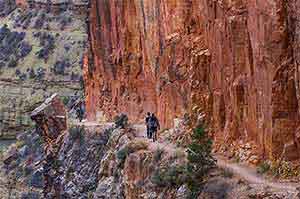Grand Canyon North Rim
Grand Canyon North Rim Lodging & Where to Stay
Because the North Rim is remote and only open during summer, lodging options are limited and often sell out months in advance. The only in-park accommodation was the historic Grand Canyon Lodge, which sadly has burned down in the Dragon Bravo Fire in the summer of 2025.
Just outside the park entrance, Kaibab Lodge offers a forested retreat 5 miles from the rim. For a quieter stay further out, Jacob Lake Inn is located about 44 miles north at the junction of US-89A and Highway 67. If you prefer sleeping under the stars, the North Rim Campground inside the park and nearby forest campgrounds offer RV sites and tent camping.
Grand Canyon North Rim Weather & Best Time to Visit
The best time to visit the Grand Canyon North Rim is from mid-May to mid-October, when all visitor services and roads are open. Due to its elevation of over 8,000 feet, the North Rim is much cooler than the South Rim:
- Summer (June–August): Pleasant days between 60–80°F; cool evenings.
- Spring & Fall: Temperatures range from 40–70°F with crisp mornings and ideal hiking conditions.
- Winter (mid-October–mid-May): Heavy snow closes access roads; the North Rim is not accessible during this time.
Always check weather forecasts before traveling and bring layers, especially for chilly nights.
North Rim Tours, Hikes & Things to Do
Although fewer guided tours operate on the North Rim, the experience is no less spectacular. The region offers unforgettable scenic overlooks, peaceful hikes, and adventure opportunities:
- Point Imperial: The highest viewpoint on the North Rim, offering dramatic canyon views.
- Cape Royal: Panoramic sights including the Colorado River and Angel’s Window.
- Bright Angel Point: A short, paved trail from the Grand Canyon Lodge to one of the most photographed viewpoints.
- Roosevelt Point & Walhalla Overlook: Ideal for photography and quiet reflection.
- Hiking Trails: Trails like Widforss Trail, Uncle Jim Point, Cape Final, and Point Sublime offer remote hiking experiences with minimal crowds.
- Mule Rides: Half-day mule rides offer a classic Grand Canyon adventure with expert guides.
How to Get to the North Rim
The most convenient way to reach the Grand Canyon North Rim is by car. Public transportation is extremely limited, and only a few companies provide shuttle service from cities like Flagstaff (fares range from $158 to $200 per person). Private tours or helicopter tours from Las Vegas are also available for luxury travelers.
- Travel to Jacob Lake, Arizona via US-89A.
- From Jacob Lake, take Highway 67 south for 44 miles (about 1 hour) to reach the North Rim entrance.
Plan Your Grand Canyon North Rim Adventure
With its dramatic landscapes, fewer crowds, and peaceful atmosphere, the Grand Canyon North Rim is perfect for nature lovers, photographers, and seasoned hikers. Book early, especially if you plan to stay at the Grand Canyon Lodge, and be sure to check seasonal access dates before your trip. Whether you're hiking to remote viewpoints or relaxing at your cabin with a canyon view, the North Rim promises a truly unforgettable Grand Canyon experience.
Best Tours
- Air tours — $300 per person
- Pros: The fastest way to get to the North Rim from Las Vegas or Phoenix/Scottsdale, and it's transportation and a tour in one
- Cons: Pricey, does not land at the North Rim of the National Park. It lands at the privately owned Bar 10 Ranch, 9 miles from the rim on the decidedly remote Arizona Strip, 80 miles by dirt road from St. George, UT.
- Guided overnight hiking & backpacking — about $200 per day per person, multiple days
- Pros: Arguably the best way to intimately experience the Grand Canyon, with all the safety, equipment and trip planning you mightn't accomplish on your own
- Cons: Must be in sufficient physical condition
- River rafting (motor) 4 day Upper Canyon — $1100 per person
- River rafting (oar) 4 day Upper Canyon &mdash $1750 per person
- Pros: These are the kind of bucket list experiences you can brag about forever. Heavy on the adrenaline!
- Cons: Not for young children, requires far advance planning and a hefty budget
Sunrise/Sunset
Mother nature presents two daily displays perhaps more spectacular than anything mankind could create. Each day at daybreak and "the magic hour," crowds gather at the North Rim's six main viewpoint areas to watch the sun appear and disappear over the Canyon rim, casting dramatic shadows and highlighting rugged textures. While it's true that there's not just one "best" place to view the sunrise and sunset, there are good and better places. These prime viewpoints obtrude southward into the canyon, with views to the east and west, and are well-suited for sunrise or sunset. More importantly, they give the viewer the chance to look into the canyon to see the effect of the changing light and shadows on the chasm walls rather than the sun itself. It's important to note that timing is more important than location; the resulting "magic show" happens for 60-90 minutes before and after precise dawn or dusk.
- Bright Angel Point
- Cape Royal/Angel's Window
Please remember to use caution and dress appropriately when walking along trails to the overlooks; in the pre-dawn hours, you'll want a flashlight and plenty of warm layers to stave off the chill, even in the peak summer months.
Attractions
Inside the National Park, there is a visitor center, gift shop and bookstore to visit. In the Kaibab National Forest, just outside the park gates, there is an additional visitor center.
Further beyond the Kaibab Plateau, there are a multitude of natural, historical, cultural and commercial attractions within approximately 400 miles. Most notably, the North Rim is part of the Grand Circle, a vast region of northern Arizona and southern Utah that includes seven national parks and recreation areas. It is a cache of treasures that will enrich your Grand Canyon trip.
- Within 150 miles
- Monument Valley Navajo Tribal Park — Kayenta
- Glen Canyon National Recreation Area — Page
- Lake Powell National Recreation Area — Page
- Vermillion Cliffs National Monument — Page
- Antelope Canyon Navajo Tribal Park — Page
- Horseshoe Bend (point of interest) — Page
- Rainbow Bridge National Monument — Page (accessible by boat or hike only)
- Lees Ferry/Marble Canyon/Navajo Bridge — Lees Ferry
- Zion National Park — Springdale, UT
- Bryce Canyon National Park — Bryce, UT
- Kolob Canyons (Zion Nat'l Park) — Cedar City, UT
- Cedar Breaks National Monument — Cedar City, UT
- Within 200 miles
- Wupatki National Monument — Cameron
- Escalante-Grand Staircase National Monument — Escalante, UT
- Within 300 miles
- Lowell Observatory — Flagstaff
- The Arboretum at Flagstaff — Flagstaff
- Pioneer Museum — Flagstaff
- Museum of Northern Arizona — Flagstaff
- Sunset Crater Volcano National Monument — Flagstaff
- Arizona Snowbowl Ski and Snowboard Park — Flagstaff
- Flagstaff Nordic Center — Flagstaff
- Wing Mountain Snow Play Area — Flagstaff
- Within 400 miles
- Petrified Forest National Park — Holbrook
- Arches National Park — Moab, UT
- Canyonlands National Park — Moab, UT
- Capitol Reef National Park — Richfield, UT
- Natural Bridges National Monument — Blanding, UT
It's Remote. Really Remote.
The Grand Canyon's North Rim is known for being remote with few developed comforts in the area, but the North Rim does feature one in-park hotel, the Grand Canyon Lodge and Cabins, plus several beautiful campgrounds and a few hotels and motels outside the park boundary in nearby small towns. Many North Rim visitors enjoy rim-to-rim hikes, but make sure to check conditions and don't forget your Backcountry Permit!
The Grand Canyon's North Rim is the outdoor enthusiast's paradise. Known for its undisturbed beauty, the North Rim offers challenging hiking trails, intimate viewpoints and opportunities to explore the Grand Canyon on Nature’s terms. The North Rim is one among several national parks in the area. This is the part of the Grand Canyon you can most easily explore Zion National Park, Bryce Canyon, Glen Canyon, Lake Powell and more.
North Rim Hotels, Lodging & Camping
Because of its far-flung location, lodging options are limited and fill up quickly. Grand Canyon insiders recommend booking a night at the the Grand Canyon North Rim about a year in advance. Some of the favorite Grand Canyon North Rim lodging options are staying at the North Rim RV camp sites and campground or taking advantage of the opportunity to enjoy the historic Grand Canyon Lodge & Cabins. Other North Rim accommodations include staying in the small towns within about 150 miles of the Kaibab Plateau like Jacob Lake; Page; Kanab, Utah; and St. George, Utah.
If you are planning to camp outside the one developed North Rim Campground (which is known as Dispersed Camping) or below the Rim, don't forget to get a Backcountry Permit up to 4 months before your arrival, and to check conditions just prior to your stay at the Canyon.
Weather
Weather is one of the number one things visitors search about the Grand Canyon (case in point: you're reading this.) Folks want to know what to expect of the temperature swings; sun, rain and snowfall; road conditions; what to pack and what to wear. We've covered these topics in depth here,
Hiking Safety
Grand Canyon offers some of the most challenging hiking and backpacking found anywhere in North America. Steep trails, intense heat, fast changing weather, and elusive water and shade combine to make for harsh conditions — even on a good day. Over 250 visitors are evacuated from the Canyon for medical emergencies by the park service Search and Rescue team each year. Proper planning and training is imperative.
The reward for those willing to make the effort, a mere fraction of the visiting public, is a chance to marvel at the unfolding beauty of the Inner Canyon. For those that are capable it is truly an experience not to be missed.
Day hikers are not required to obtain a permit from the park service. They should choose their route carefully, and let someone know where they are going and when they plan on returning. Each year several day hikers become lost or disoriented in the Canyon, and several perish as a result. Don't become a statistic. Do your homework, don't take any undue risks, and stay well within your known limits in terms of physical exertion.
Plan for twice as much time and effort to go up than it takes to go down. As with all day hikes, get a reliable weather forecast and dress accordingly, wear sturdy shoes and a brimmed hat, and take a gallon of water per person, plus salty snacks for each person in your party.
The best day hike for newcomers to the Grand Canyon is a descent of the Bright Angel Trail. This historic trail begins in Grand Canyon Village on the South Rim and tumbles seven miles to the Colorado River below. However, going to the river and back in a single day is strongly discouraged for any hiker on any day. The good news is that there are obvious places to change course and head back uphill, including rest houses (with treated drinking water during the hot summer months) which are found at 1.5 mile increments between the top and Indian Garden Campground, located halfway to the bottom.
Cell Service
Cell phone service is intermittent at times, both on the Rim and certainly down in the Inner Canyon. Not all wireless providers offer coverage in the Grand Canyon, especially at the North Rim. Be careful not to rely on your cell or smartphone for all your directions, reservations, up-to-the-minute weather and emergency safety needs while at the Grand Canyon.
POPULAR GRAND CANYON NORTH RIM TOURS
Maverick Helicopter Tours from GCNP Airport
Canyon Spirit is a Grand Canyon helicopter tour that departs from the South Rim, taking you over the beautiful Kaibab National Forest, home to the world's largest stand of Ponderosa pines. Upon reaching the edge, the rim drops away as the magnificent Grand Canyon comes into full view.… More
Canyon Spirit is a Grand Canyon helicopter tour that departs from the South Rim, taking you over the beautiful Kaibab National Forest, home to the world's largest stand of Ponderosa pines. Upon reaching the edge, the rim drops away as the magnificent Grand Canyon comes into full view.
Leaves from Grand Canyon/Tusayan | Family-Friendly | Professionally Guided
Maverick Helicopter Tours from Las Vegas
Leaves from Las Vegas
Papillon Grand Canyon Helicopters
Family-Friendly | Leaves from Las Vegas | Leaves from Grand Canyon/Tusayan | Optional Skywalk Tour
Arizona Private Tours
Leaves from Flagstaff | Family-Friendly | Custom Options Available | Professionally Guided
Wildland Trekking
Popular Hikes | Professionally Guided | Popular Hikes | Leaves from Flagstaff | Leaves from Grand Canyon/Tusayan
